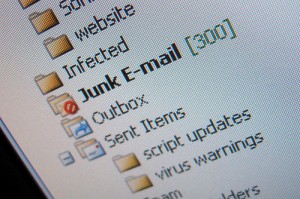Spam, or junk mail is defined as identical, disruptive e-emails sent to a large amount of e-mail or cellphone users. When a receiver clicks on one of the links in the message, he/she is diverted to a phishing website or websites containing malware. Spam e-mails can also contain hidden malware scripts.  The opposite of spam is, believe it or not, ham. In other words e-mails you WANT to receive.
The opposite of spam is, believe it or not, ham. In other words e-mails you WANT to receive.
The origin of the meaning of spam in this context, can be laid at the feet of the obscure British comedians known as Monty Python. In a 1970 sketch a group of Vikings in a restaurant starts chanting the word “spam” so incessantly that no-one else can have a conversation. Click here if you’d like to see the original Monty Python sketch where the word “spam” is mentioned 132 keer times in a mere three and a half minutes.
Even Google is amused by die word. The company once hid a surprise in their gmail users’ spam folder. When you clicked on your Spam folder, a webclip containing a variety of recipes for the original variety of spam. Amongst others recipes for “Spam Primavera”, “Spam Swiss Pie”, “Creamy Spam Broccoli Casserole” and “Spam Veggie Pita Pockets”. The first spam was sent on 3 May 1978 to advertise a new computer system. It was sent to 600 ARPANET users and all 600 names were typed in by hand from a printed document. You can read the original e-mail here.
It is estimated that, from August 2010, 200 billion spam messages are sent per day. Lucky for Stellenbosch campus users, we have a fairly strict spam filer and huge amounts of spam bypass your inbox every day. If you still receive unnecessary spam, there are ways to decrease it even more. If it makes you feel any better though – according to Steve Ballmer, Microsoft CEO, Bill Gates receives four million e-mails a year and most of it’s spam.
SOURCES: http://blog.emailaddressmanager.com, http://mashable.com & www.wikipedia.org
Gemorspos, of te wel “spam”, is wanneer identiese, meestal steurende, boodskappe na `n groot hoeveelheid e-pos- of selfoongebruikers gestuur word. As `n ontvanger kliek op een van die skakels in die boodskap, word hulle herlei na strikroof webwerwe of webwerwe wat “malware” huisves. “Spam” e-posse kan ook versteekte “malware” skripte bevat.  Die teenoorgestelde van “spam” – met ander woorde e-posse wat jy WIL ontvang, word natuurlik “ham” genoem. (ja regtig)
Die teenoorgestelde van “spam” – met ander woorde e-posse wat jy WIL ontvang, word natuurlik “ham” genoem. (ja regtig)
Die eintlike oorsprong van die woord “spam” hou verband net die oorspronklike, geprosesseerde variasie en ons het die obskure Britse groep komediante van Monty Python om te blameer daarvoor. In die 1970 skets sing-praat `n groep Vikings die woord “spam” so onophoudelik in `n restaurant dat niemand anders kan praat nie. Kliek hier as jy die oorspronklike Monty Python skets wil sien waar die woord “spam” 132 keer gebruik word in 3 en `n half minute!
Selfs Google vind die woord interessant. Die maatskappy het op `n stadium `n verrassing versteek vir hulle gmail-gebruikers. As jy jou se “spam” leêr sou oopmaak, het dit omgeskakel na `n webinsetsel met `n verskeidenheid resepte vir regte spam. Onder andere resepte vir “Spam Primavera”, “Spam Swiss Pie”, “Creamy Spam Broccoli Casserole” en “Spam Veggie Pita Pockets”. Die eerste gemorspos is reeds op 3 Mei 1978 gestuur om `n nuwe rekenaarstelsel te adverteer. Dis gestuur vir 600 gebruikers van ARPANET en al 600 adresse is met die hand ingetik vanaf `n uitgedrukte dokument. Jy kan die e-pos hier lees.
Vanaf Augustus 2010 word daar geskat dat daagliks ongeveer 200 biljoen gemorspos boodskappe gestuur word. Gelukkig gebruik ons op kampus redelike streng gemorspos filters om groot hoeveelheide onnodige e-posse uit ons posbusse te hou. As jy egter nogsteeds te veel kry na jou sin, gaan lees gerus hier. As dit jou enigsins beter laat voel – volgens Steve Ballmer, CEO van Microsoft, kry Bill Gates vier miljoen e-posse per jaar, waarvan die meeste gemorspos is.
SOURCES: http://blog.emailaddressmanager.com, http://mashable.com & www.wikipedia.org

